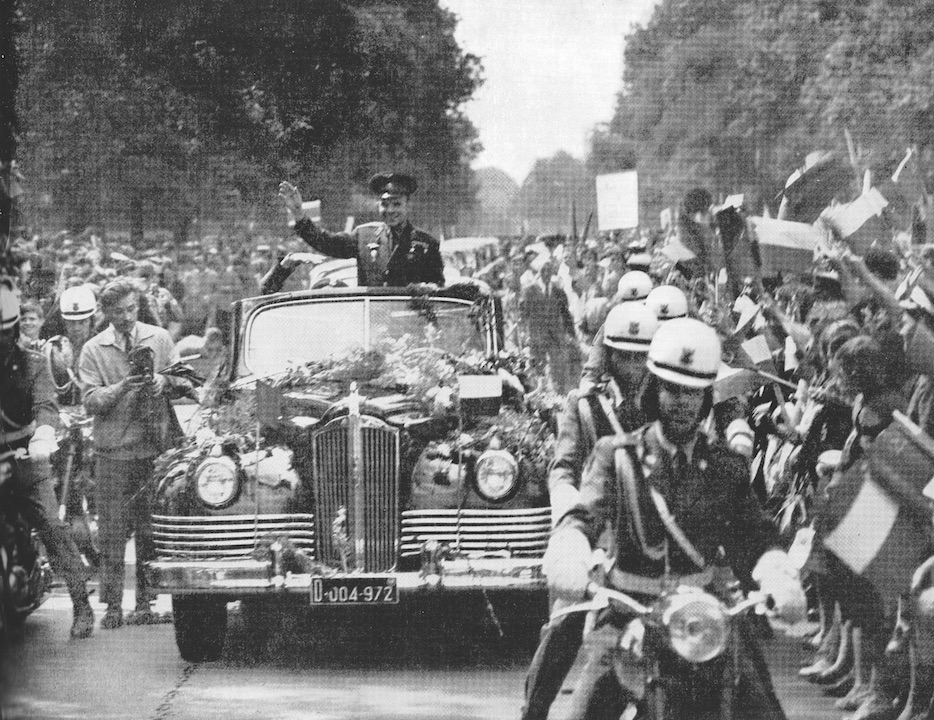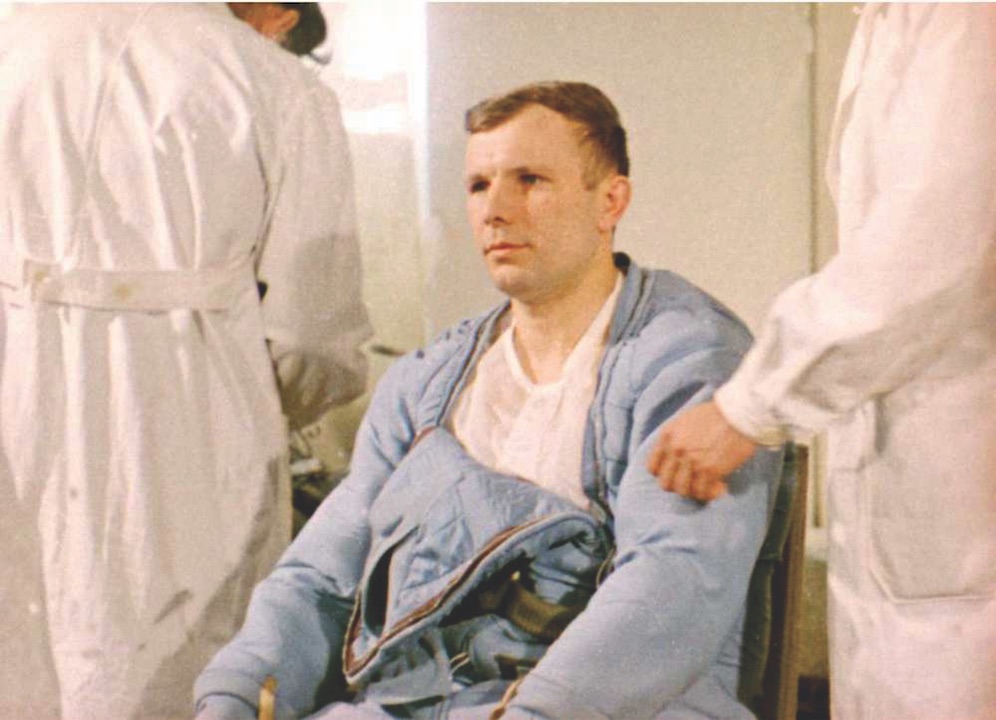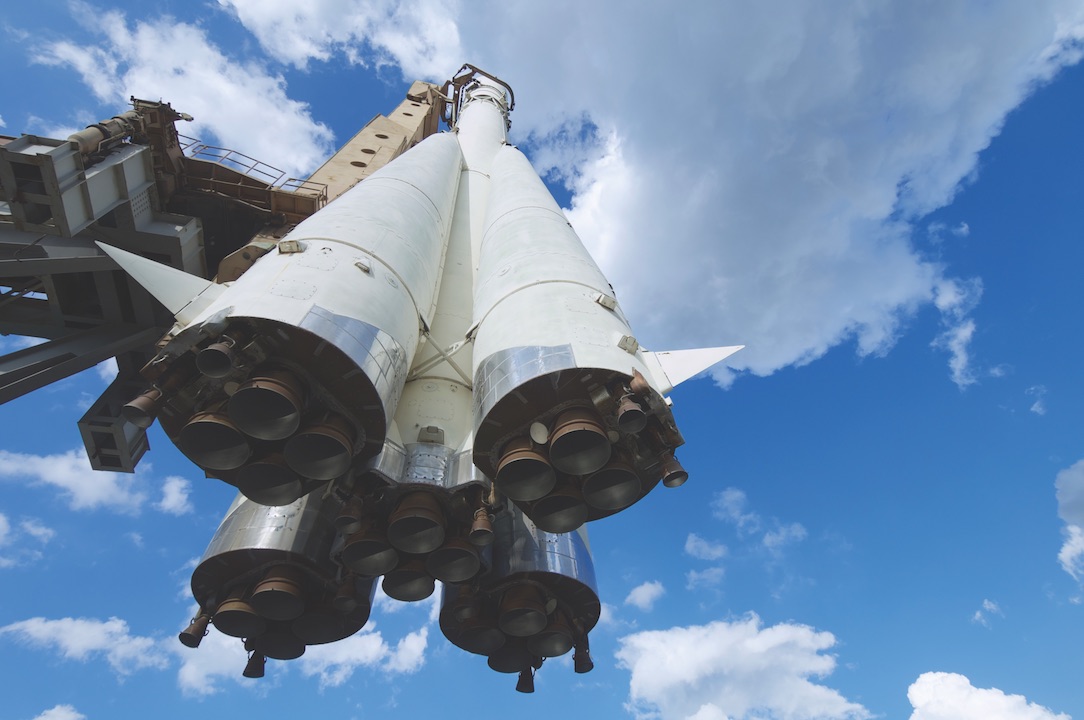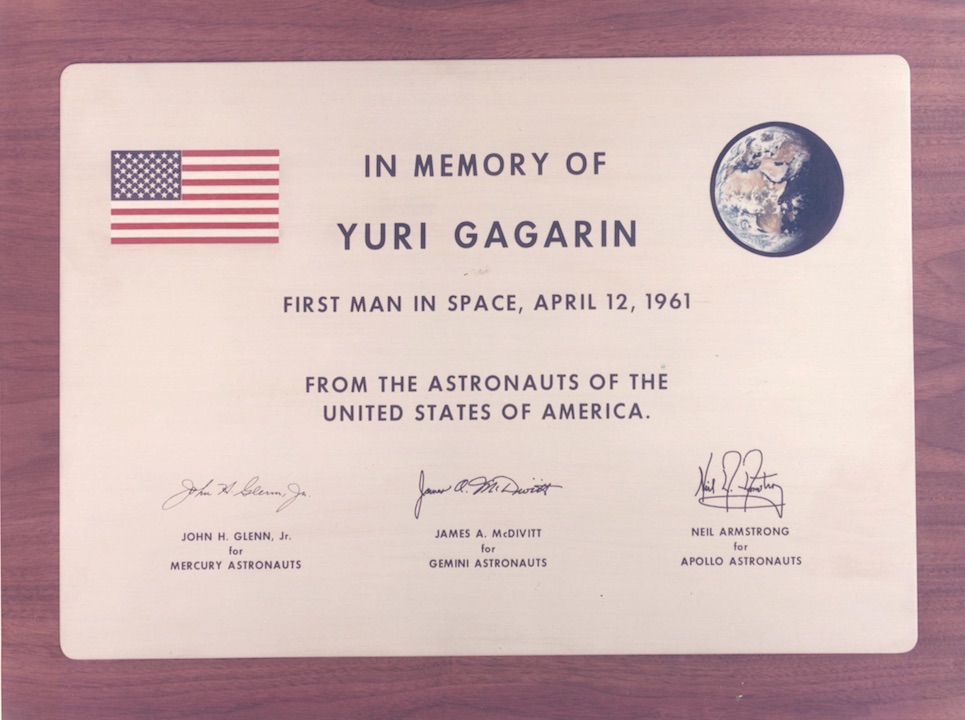Yuri Gagarin: How the first man in space sparked a conspiracy theory
Before the cosmonaut orbited the Earth, rumors abounded that someone else already had.

Everybody knows that Neil Armstrong was the first person to set foot on the moon. Most are also aware that he wasn't the first to go into space. After all, Alan Shepard paved the way for American astronauts on May 5, 1961, while Soviet cosmonaut Yuri Gagarin stole a march by rocketing into Earth orbit a few weeks earlier on April 12. Or did he?
Today Gagarin's name is cemented in the record books, and he instantly became a national hero across the Soviet Union. Presented as a triumph of the fiercely fought Space Race against the U.S., the 27 year old, who had been chosen just three days before the mission, spent 108 minutes in space, orbited the Earth and returned fit and well following a drama-filled flight.
And yet, before he even embarked on his journey skywards, doubt was seeded in many a person's mind. For rumors had surfaced that the Soviets had successfully launched a man into space before Gagarin set foot in Vostok 1, and the talk was that one cosmonaut had done so on April 7, just five days earlier.
Dennis Ogden, the Moscow-based correspondent for the British Communist Party newspaper, Daily Worker, reported as such, his story splashed across the publication's front page with the headline: "The First Man In Space". It informed readers that the spaceman — "the test-pilot son of a top-ranking aircraft designer" — was "back alive, but suffering from [the] effects of his flight".
A lost cosmonaut conspiracy theory begins
Gagarin's feet hadn't even left the ground when the paper hit the newsstands, and it caused something of a stir, sparking the first whispers of a conspiracy theory which has continued to this day. The Soviet Union denied the reports and instead alerted the press to Gagarin's subsequent feat. Ogden also reported this, his article again making the splash as he wrote of a "hero's welcome" and a Soviet Union "wild with joy at [the] first trip outside this world".
Ogden's article could have been seen as something akin to a correction; confirmation that he was initially wrong about the flight on April 7. But then French journalist Eduard Bobrovsky followed up on Ogden's claims and pointed to the man in question as being an accomplished test pilot called Vladimir Ilyushin, while also stating the flight actually took place on March 25.
Get the world’s most fascinating discoveries delivered straight to your inbox.
Trouble is, this mission had — according to the press sources — not gone quite as well as planned. That is why, it has long since been claimed, Ilyushin's feat was cast aside in favor of Gagarin's successful launch and landing.
Ilyushin was a Soviet general and a test pilot of high standing. He had broken many speed and altitude records and his father was influential, having designed and built Second World War fighters and bombers. Ilyushin senior had also earned himself a place in government. To that end, his son would have been seen as the perfect person to send into space, his penchant for risk-taking such that the then-34-year-old pilot would have surely relished the task.
And so the story went that his journey outwards on board his spaceship was fine but, after three supposed orbits, Ilyushin's return went awry. Apparently, his landing was off-course, causing him physical harm and mental anguish. There was even a suggestion that the accident had put him into a coma.
"The space vessel reportedly was recovered where expected, but Ilyushin was mentally unbalanced and is unconscious in a Moscow hospital," said a report in The Spokesman Review about the journalist's claims on April 12, 1961. The article adds that Bobrovsky said his information came from reliable sources that he could not name and that Russian officers denied the report.
The Soviet Union claimed Ilyushin was in hospital being treated for injuries he had received in a car accident. The Soviets were not the only ones blinking with disbelief at this. Even the Americans did not believe the journalists' claims. Indeed, Pierre Salinger, the press secretary to the White House at the time, told reporters that there was no evidence of a flight on April 7 and, we have to assume, nothing to have raised suspicion in March either. North American Aerospace Defense Command (NORAD) space tracking stations, it transpired, had not picked up on anything, and the U.S. was not about to leap in and heap embarrassment on the Soviet Union without proof.
And yet, even this wasn't enough to completely quell suspicion. Some journalists believed the claims of a car crash were a mere cover story, and it certainly wasn't beyond the wildest of imaginations to believe the Soviets would seek to bury a mistake since it had been done so many times in the past.
What's more, in the framework of the Space Race, conspiracists could surmise there was a valid reason for trying to bury such a failure: the Soviets would constantly pull out all the stops to present communism as the superior ideology.
Related: Are we really in a new space race with China and Russia?
But is that, together with unknown journalistic sources, reason enough to believe that Gagarin's place in history was not quite what it was? Ogden would later claim that he saw a photograph of Ilyushin wearing space gear at the time of the supposed flight, but it has never subsequently surfaced. Meanwhile, Ilyushin himself — who died in 2010, aged 82 — never confessed to having flown into space. He lived to tell the claimed tale, but notably did not.
What has been seen, however, are rumours continuing to swirl long after the event, and they've even been fleshed out. One of the most notable was a 52-minute documentary in 1999 called "The Cosmonaut Cover-Up", released by Global Science Productions and directed by Elliott Haimoff who, in the following year, also helmed "Vladimir Ilyushin: The Real First Man in Space".
Widely broadcast, it claimed Ilyushin had failed to eject from his capsule, crashed in China and, after being captured, was eventually handed back to the U.S.S.R. in 1962. The documentary makers said Ilyushin wouldn't talk about the alleged incidents on camera, according to an article published on Sun Community News, and preferred to maintain his secrecy.
But was Ilyushin so fearful that, in verifying such claims, he would open himself up to a world in which he did not wish to boldly go? Given that the documentary was being made a number of years after the collapse of the Soviet Union, when secrets were finally being divulged and historical events were being flung open, many would suspect not.

This article is brought to you by All About Space.
All About Space magazine takes you on an awe-inspiring journey through our solar system and beyond, from the amazing technology and spacecraft that enables humanity to venture into orbit, to the complexities of space science.
In fact, the Soviets began to open up well before the U.S.S.R. ceased to be. In 1980 the West finally learned of the death of Valentin Bondarenko, who according to The New York Times, died ten days into a 15-day low-pressure endurance experiment in Moscow in 1961 when fire broke out — even though they had removed his image from an official subsequent training photograph.
It took longer to tell the world of a major launchpad accident that took place on Oct. 24, 1960, and officially killed 78, as eventually revealed to the rest of the world in 1989. There's talk of Gagarin being used for propaganda, but of all the confessions and documents seen since the Soviet Union collapsed, Ilyushin has never featured.
And yet there have been some peculiar pieces of "evidence". Two Italian former amateur radio operators, Achille and Giovanni Judica-Cordiglia, claimed to have recorded audio from an orbiting capsule in the days before Gagarin made his flight, and it was actually the fourth slice of startling audio released by the pair.
The first was from May 1960 of a manned spacecraft reportedly going off-course; the second in November that year of an SOS Morse code from a troubled spacecraft leaving Earth's orbit and, most chillingly, a third in 1961 of a cosmonaut apparently suffocating to death. Should these be hard-and-fast evidence of spaceflights, then we would have to say that not only was Gagarin not the first person into space, Ilyushin was perhaps not first either. But given the supposition was that everyone involved in those three recordings had died, discovering the truth has been even more difficult. And yet theories still mount up.
Who was the first man in space?
What could be made of claims by Mikhail Rudenko, a former Soviet senior engineer and experimenter with Experimental Design Office 456, formed in 1999 by members of the editorial staff of the oldest Soviet paper Pravda, that cosmonauts had been sent into space in 1957, 1958 and 1959?
"All three pilots died during the flights and their names were never officially published," he is quoted as saying in an article published on pravda.ru on April 12, 2001, having explained that the pilots involved were called Ledovskikh, Shaborin and Mitkov and took part in sub-orbital flights. "The cosmonauts were to reach space heights in the highest point of such an orbit and then return to the Earth," he added. But considering Pravda has also run with headlines such as "Aliens forced Americans out from the Moon'' and "Alien and human skulls found on Mars", it's a tough call.
Harder still to determine is Ilyushin's location in March and April 1961. The Soviets didn't help themselves in this regard either since they couldn't give a straight answer about the reason why he was seen to be injured — pinned down to that car crash — or when it actually took place. Neither could they offer up a suitable explanation for why he might have been in China. They also went as far as to say he was never actually a cosmonaut and, indeed, it would appear that he wasn't in the original cosmonaut team. No memoirs or declassified information put him there.
Yet it's also difficult to corroborate the Judica-Cordiglia recordings with any data from official sources. Listening stations did not pick up on what they claimed to have committed to tape, and radio astronomer Bernard Lovell, who established the Jodrell Bank Observatory in Cheshire, England, dismissed claims of earlier Russian manned space attempts in 1963.
Even that, however, isn't as clear cut as it sounds. Lovell paid visits to Russia around this time, and there have even been allegations that he was brainwashed. He fell ill that year following such a trip, and the U.K. Ministry of Defence said it might have been due to an attempt to remove his memory of a Soviet offer to build a telescope facility in the U.S.S.R. His son says he was merely ill from exhaustion, according to an article published in February’s edition of Physics World magazine. And that sounds more plausible.
Related: Russia's next space station-bound Soyuz spacecraft named for first cosmonaut
Besides, supposing Russia had suffered such terrible space attempts which resulted in deaths and crashes, would it really have announced Gagarin's flight in the way it did?
As James E. Oberg points out in a 1975 article he wrote in Space World magazine, the Russian news agency TASS — frequently used as a front organisation by the Soviet intelligence agency — released its first bulletin while Gagarin was still in-flight. If it was worried about the potential for bad news, wouldn't it have been better to wait until the mission was over and Gagarin's feet were firmly back on the ground, rather than risk Gagarin's spacecraft hitting the same problems as the one claimed to have taken place just days before?
Maybe we will never know. The two men who would have been directly involved are no longer alive — Gagarin was killed when the MiG-15 training jet he was piloting crashed on March 27, 1968, when he was 34. Given the evidence that has been made available, the smart money remains on Gagarin having been the first person on a manned spaceflight Russian space history can be murky and difficult to pick apart, but in truth there is no real reason to lie in instances such as this.
Additional resources:
- Read more about the Vostok Program
- Learn about the Jodrell Bank Observatory
- The most extreme records in human spaceflight
David Crookes is a UK-based science and technology journalist who has been writing professionally for more than two decades. Having studied at the University of Durham in England, he has written for dozens of newspapers, magazines and websites including The Independent, The i Paper, London Evening Standard, BBC Earth, How It Works and LiveScience. He has been a regular contributor to Space.com's sister publication, All About Space magazine since 2014.










